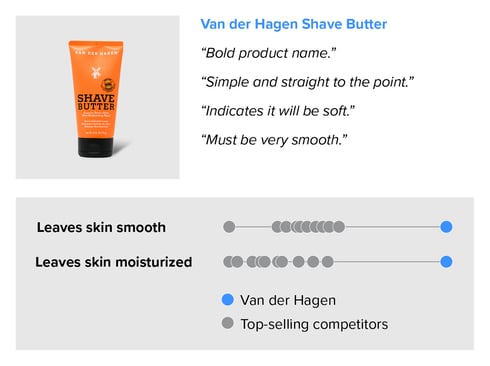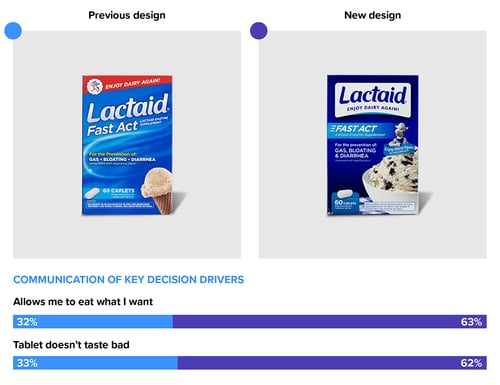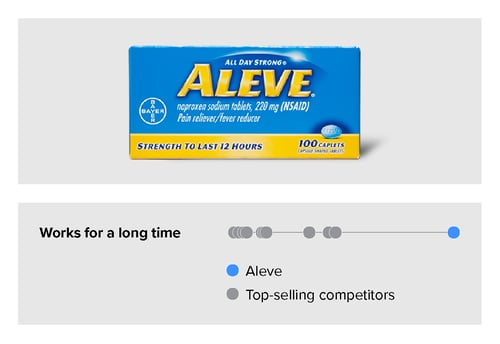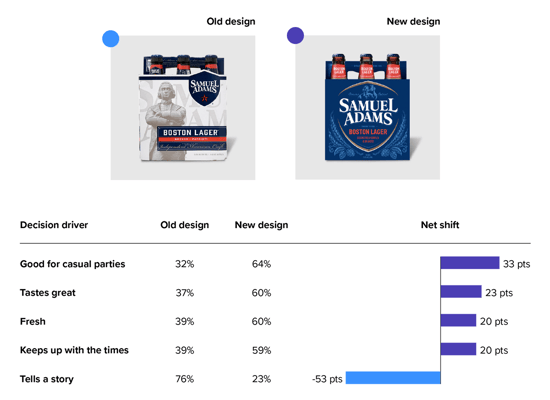Package design needs to communicate a lot with very limited space—and it needs to do it in a way that's concise, compelling, specific to the product category, and meaningful to the consumer. In fact, effective communication is one of the most influential drivers of a successful package redesign; based on Designalytics' analysis of more than 100 redesigns, we found that improving communication of the attributes most likely to drive purchase in a given category almost always correlates with an increase in purchase preference.1 This may seem obvious, but improvements on other metrics—such as standout and overall visual appeal—tend to have a weaker tie with purchase preference than communication does.
So how can brands optimize their on-pack communication? Based on data from the hundreds of package designs that Designalytics has evaluated to date, we've observed a few visual strategies that many brands have employed with marked success.2
-
Allude to a specific benefit in your product name.
On-target product names can forge mental short-cuts to specific functional or sensory benefits. For example, Van der Hagen’s Shave Butter outpaces many better-known competitors by a wide margin when it comes to communicating “leaves skin smooth” and “leaves skin moisturized”—top-ranked decision drivers in the men’s shaving category. Given the minimal imagery included on the package, this "buttery" brand can thank its evocative naming strategy for driving these perceptions.

-
Use appealing sensory cues.
Stimulating the senses through tasty visuals is one of the fastest paths to consumers’ hearts (and stomachs). Consumers consistently cite visuals related to taste and scent as the most engaging and resonant elements across package designs. For example, consider the recent redesign for Lactaid tablets; the old design featured an uninspired vanilla ice cream cone relegated to the corner of the package, while the redesign features a comparatively larger and more tempting bowl of cookies-and-cream ice cream that looks much more realistic. Not surprisingly, the new design performs significantly better than the old design when it comes to communicating taste-related attributes.

-
Leverage compelling efficacy claims.
When you only have so many seconds to catch consumers’ attention, any claims included on your package need to be clear and concise. In today's image-driven culture, it might be tempting to omit any unnecessary copy altogether—but our research shows that claims can make a powerful impression, specifically in categories where functional benefits play an important role, such as OTC medication, personal care, and home care. For example, Aleve ranks number one on the “works for a long time” attribute, most likely due to its "strength to last 12 hours" claim. Similarly, Crest 3D White toothpaste ranks number one on the "whitens my teeth" attribute, thanks to its claim to "remove 80% of surface stains," which is printed prominently on the packaging.

-
Be selective in your attributes.
Trying to communicate too many things on a package can muddle the conversation that your brand is trying to have with consumers. For example, consider Samuel Adams Boston Lager's recent redesign; the previous packaging emphasized the brand’s patriotic heritage, while the new design adopts a simpler communication approach that spotlights the brand name. A comparison of consumers' reactions suggests that the old design eclipsed positive associations that consumers already held for the brand—including those related to flavor and quality. While the new design performs more poorly on "tells a story," it does leave room for other more important attributes to shine through.

Communicating with consumers through packaging requires artfully balancing the right visuals and copy in the limited space provided. But first, it requires understanding which attributes are most influential in driving purchase in your category, how consumers view your brand's specific execution of design elements (which can often be surprising), and where opportunities exist in the competitive landscape to strengthen your brand's hold on important attributes. Brands with objective, data-driven answers to these questions tend to communicate better at the shelf—and ultimately compel more consumers to make a purchase.
Want to read the full report with tips for improving on several design performance measures? Download it here.
1Designalytics determines the attributes that are most influential in driving purchase in each product category through quantitative, independent consumer research.
2The principles shared here are based on the hundreds of package designs that Designalytics has tested to date. However, none of these principles always holds true. As all designers know, there are no universal rules for developing effective designs. Design success depends heavily on the specific category and competitive context, as well as a particular brand’s positioning and design objectives.




